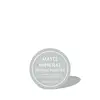What's inside
What's inside
 Key Ingredients
Key Ingredients

 Benefits
Benefits

 Concerns
Concerns

 Ingredients Side-by-side
Ingredients Side-by-side

Silica
AbrasiveCorn Starch Modified
AbsorbentDimethicone/Vinyl Dimethicone Crosspolymer
Skin ConditioningCaprylic/Capric Triglyceride
MaskingMica
Cosmetic ColorantMethicone
EmollientEthylhexylglycerin
Skin ConditioningDimethicone
EmollientGlyceryl Caprylate
EmollientWater
Skin ConditioningEthylene/Acrylic Acid Copolymer
Emulsion StabilisingMineral Salts
Skin ConditioningButylene Glycol
HumectantMentha Arvensis Leaf Extract
MaskingCamellia Sinensis Leaf Extract
Antimicrobial1,2-Hexanediol
Skin ConditioningPhenoxyethanol
PreservativeSilica, Corn Starch Modified, Dimethicone/Vinyl Dimethicone Crosspolymer, Caprylic/Capric Triglyceride, Mica, Methicone, Ethylhexylglycerin, Dimethicone, Glyceryl Caprylate, Water, Ethylene/Acrylic Acid Copolymer, Mineral Salts, Butylene Glycol, Mentha Arvensis Leaf Extract, Camellia Sinensis Leaf Extract, 1,2-Hexanediol, Phenoxyethanol
Silica
AbrasiveAluminum Starch Octenylsuccinate
AbsorbentVinyl Dimethicone/Methicone Silsesquioxane Crosspolymer
Ethylene/Acrylic Acid Copolymer
Emulsion StabilisingMica
Cosmetic ColorantMethicone
Emollient1,2-Hexanediol
Skin ConditioningGlyceryl Caprylate
EmollientHydrogenated Lecithin
EmulsifyingLavandula Angustifolia Water
MaskingButylene Glycol
HumectantRose Flower Oil
MaskingJuniperus Mexicana Oil
MaskingCamellia Sinensis Leaf Extract
AntimicrobialCetearyl Alcohol
EmollientGlyceryl Stearate
EmollientStearic Acid
CleansingAlteromonas Ferment Filtrate
HumectantEthylhexyl Isononanoate
EmollientGossypium Herbaceum Extract
Skin ConditioningPhytosteryl/Isostearyl/Cetyl/Stearyl/Behenyl Dimer Dilinoleate
Skin ConditioningGlycine Soja Sterols
EmollientHydroxypropyl Bispalmitamide Mea
EmollientSodium PCA
HumectantMeadowfoam Estolide
Skin ConditioningSodium Lactate
BufferingLecithin
EmollientCeramide NP
Skin ConditioningCetearyl Glucoside
EmulsifyingHydrogenated Polydecene
EmollientArginine
MaskingHydroxyethyl Urea
HumectantAspartic Acid
MaskingPCA
HumectantGlycosphingolipids
EmollientGlyceryl Citrate/Lactate/Linoleate/Oleate
EmulsifyingCeteareth-20
CleansingButyrospermum Parkii Butter
Skin ConditioningGlycine
BufferingAlanine
MaskingSerine
MaskingValine
MaskingDipotassium Glycyrrhizate
HumectantIsoleucine
Skin ConditioningThreonine
Proline
Skin ConditioningPhenylalanine
MaskingHistidine
HumectantCeramide AP
Skin ConditioningTocopheryl Acetate
AntioxidantSilica, Aluminum Starch Octenylsuccinate, Vinyl Dimethicone/Methicone Silsesquioxane Crosspolymer, Ethylene/Acrylic Acid Copolymer, Mica, Methicone, 1,2-Hexanediol, Glyceryl Caprylate, Hydrogenated Lecithin, Lavandula Angustifolia Water, Butylene Glycol, Rose Flower Oil, Juniperus Mexicana Oil, Camellia Sinensis Leaf Extract, Cetearyl Alcohol, Glyceryl Stearate, Stearic Acid, Alteromonas Ferment Filtrate, Ethylhexyl Isononanoate, Gossypium Herbaceum Extract, Phytosteryl/Isostearyl/Cetyl/Stearyl/Behenyl Dimer Dilinoleate, Glycine Soja Sterols, Hydroxypropyl Bispalmitamide Mea, Sodium PCA, Meadowfoam Estolide, Sodium Lactate, Lecithin, Ceramide NP, Cetearyl Glucoside, Hydrogenated Polydecene, Arginine, Hydroxyethyl Urea, Aspartic Acid, PCA, Glycosphingolipids, Glyceryl Citrate/Lactate/Linoleate/Oleate, Ceteareth-20, Butyrospermum Parkii Butter, Glycine, Alanine, Serine, Valine, Dipotassium Glycyrrhizate, Isoleucine, Threonine, Proline, Phenylalanine, Histidine, Ceramide AP, Tocopheryl Acetate
Ingredients Explained
These ingredients are found in both products.
Ingredients higher up in an ingredient list are typically present in a larger amount.
1,2-Hexanediol is a synthetic liquid and another multi-functional powerhouse.
It is a:
- Humectant, drawing moisture into the skin
- Emollient, helping to soften skin
- Solvent, dispersing and stabilizing formulas
- Preservative booster, enhancing the antimicrobial activity of other preservatives
Butylene Glycol (or BG) is used within cosmetic products for a few different reasons:
Overall, Butylene Glycol is a safe and well-rounded ingredient that works well with other ingredients.
Though this ingredient works well with most skin types, some people with sensitive skin may experience a reaction such as allergic rashes, closed comedones, or itchiness.
Learn more about Butylene GlycolCamellia Sinensis Leaf Extract is derived from the leaves of the tea plant. Black tea, green tea, and oolong tea are all harvested from this plant.
This ingredient has many skin benefits:
This ingredient contains polyphenols, a strong antioxidant. Antioxidants help fight off molecules that damage skin cells.
On top of that, the antioxidants in green tea neutralize free-radicals from the sun. This gives the skin some extra UV protection, but should not replace sunscreen.
Many components of tea have anti-inflammatory properties.
Polyphenols and L-theanine help soothe the skin and reduce irritation. The caffeine in Camellia Sinensis Leaf Extract helps calm inflamed blood vessels.
Other compounds found in tea include: Vitamin Bs, linoleic acid, magnesium, calcium, iron, and zinc.
Research has shown both drinking Camellia Sinensis Leaf Tea and applying it to the skin can help boost skin elasticity and hydration. Studies also show using tea extract may reduce sebum, or oil, production.
Learn more about Camellia Sinensis Leaf ExtractWe don't have a description for Ethylene/Acrylic Acid Copolymer yet.
Glyceryl Caprylate comes from glycerin and caprylic acid, a fatty acid from coconut. It has emollient and emulsifier properties.
As an emollient, it helps hydrate your skin. Emollients work by creating a barrier on your skin to trap moisture in, helping to keep your skin soft and smooth.
On the other hand, emulsifiers prevent ingredients (such as oil and water) from separating.
Learn more about Glyceryl CaprylateMethicone is a type of silicone and is a simpler form of dimethicone.
Silicones are used to enhance the texture of products and have emollient properties. Methicone is used to give products a silky texture and improves spreadability.
Mica is a naturally occurring mineral used to add shimmer and color in cosmetics. It can also help improve the texture of a product or give it an opaque, white/silver color.
Serecite is the name for very fine but ragged grains of mica.
This ingredient is often coated with metal oxides like titanium dioxide. Trace amounts of heavy metals may be found in mica, but these metals are not harmful in our personal products.
Mica has been used since prehistoric times throughout the world. Ancient Egyptian, Indian, Greek, Roman, Aztec, and Chinese civilizations have used mica.
Learn more about MicaSilica, also known as silicon dioxide, is a naturally occurring mineral. It is used as a fine, spherical, and porous powder in cosmetics.
Though it has exfoliant properties, the function of silica varies depending on the product.
The unique structure of silica enhances the spreadability and adds smoothness, making it a great texture enhancer.
It is also used as an active carrier, emulsifier, and mattifier due to its ability to absorb excess oil.
In some products, tiny microneedles called spicules are made from silica or hydrolyzed sponge. When you rub them in, they lightly polish away dead skin layers and enhance the penetration of active ingredients.
Learn more about Silica